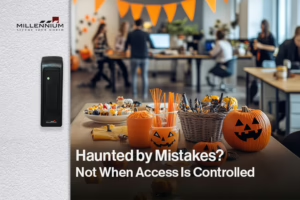Introduction: The Rising Cost of Retail Crime
Retail crime has evolved from isolated shoplifting incidents into a $100 billion+ nationwide problem. According to the National Retail Federation and Investopedia, U.S. retailers lost more than $112 billion in 2022 due to theft, shrinkage, and organized retail crime (ORC). For store owners and retail chains alike, these numbers aren’t just statistics — they represent shrinking profit margins, eroded customer trust, and increasing operational risk.
As retail environments become more complex, from open layouts to 24/7 e-commerce integration, traditional security models are failing to keep up. To truly protect inventory, employees, and customers, retailers must adopt unified access control and integrated physical security systems that work seamlessly together.
The Real Cost of Retail Crime for Store Owners
Retail crime doesn’t just impact merchandise—it affects every layer of a store’s operation. Direct losses from theft and shrinkage cut into profit margins, but the indirect costs are often even higher. These include increased insurance premiums, staff turnover, and the expense of manual investigations.
Independent retailers often face the hardest hit, as each stolen product directly reduces their limited revenue. Larger retail chains, while better equipped technologically, struggle with maintaining consistent security standards across multiple locations. For both, the message is clear: reactive measures like traditional cameras or unmonitored alarms aren’t enough.
Loss prevention strategies must now integrate access control for retail stores, combining surveillance with credential-based entry, staff accountability, and centralized reporting to reduce both theft and internal fraud.
The Rise of Organized Retail Crime and Complex Threats
Organized Retail Crime (ORC) has become one of the biggest challenges for U.S. retailers. The U.S. Chamber of Commerce reports that over 70% of retailers have experienced a rise in ORC incidents, with average losses nearing $700,000 per $1 billion in sales.
These groups are increasingly sophisticated—coordinating theft rings, exploiting store vulnerabilities, and reselling goods online. But it’s not just external actors; insider theft and return fraud also contribute significantly to shrinkage.
For multi-store chains, these issues multiply as inventory and personnel move between sites. Without a unified physical security system that centralizes access permissions, video analytics, and alert mechanisms, retail security teams often react too late—after losses have occurred.
Why Traditional Security Measures Are No Longer Enough
Legacy systems such as standalone CCTV or simple lock-and-key methods once sufficed for small retail stores. But with self-checkout systems, automated stockrooms, and multi-channel operations, these outdated tools cannot offer complete visibility or control.
Traditional systems are reactive, identifying incidents only after damage occurs. Moreover, they lack integration — meaning that access logs, surveillance footage, and alarms operate in silos. This separation makes it nearly impossible to correlate entry data with suspicious behavior in real time.
To combat today’s retail threats, businesses must adopt unified access control systems that merge door access, surveillance, intrusion detection, and analytics into one ecosystem—enabling proactive threat detection and faster response.
Unified Access Control and Physical Security — What It Means
Unified access control combines multiple physical security layers—such as door readers, biometric access, mobile credentials, and surveillance—into a single management platform. This allows retailers to monitor, control, and audit every entry point across multiple stores from one dashboard.
In a unified system:
- Each employee has role-based access permissions.
- Access control integrates with video systems to match identity with behavior.
- Alerts trigger when unusual activity occurs, such as after-hours entries or repeated failed access attempts.
Such integrated retail security systems don’t just deter theft—they help optimize operations, enhance staff safety, and provide an auditable trail for compliance or insurance claims.
Unified access control goes beyond basic entry management — it’s about bringing every physical security element together under one intelligent ecosystem. When a door opens, a camera records; when a restricted zone is accessed, analytics flag it in real-time. This synchronization allows for faster verification and more efficient security oversight.
For retail chains with hundreds of doors, employees, and contractors, such centralization eliminates blind spots. It ensures that store managers, regional heads, and security teams have complete visibility across all locations—reducing insider threats, unauthorized after-hours entries, and unrecorded activity. In essence, unified security doesn’t just protect — it empowers decision-making and accountability across retail operations.
Download the Cloud Access Control Checklist
your 15-step, printable guide to building a secure, scalable, and cloud-ready system.
Includes: PoLP setup, MFA guide, permission audit worksheet + a bonus printable template.
Key Components Retailers Should Deploy
A comprehensive retail security solution should include:
- Role-Based Credentials: Different permissions for staff, managers, vendors, and cleaners.
- Mobile Access Control: Employees can unlock secured areas via smartphones, reducing the need for physical keys or cards.
- Video and Access Integration: Combine access logs with live or recorded footage for incident verification.
- Cloud-Based Management: Enables central monitoring of multiple stores, ideal for retail chains.
- Analytics and Reporting: Dashboards that visualize shrink trends, access violations, and security incidents.
Together, these technologies form a unified security architecture that allows retailers to detect, deter, and respond to threats instantly.
A comprehensive retail security solution should combine flexibility, scalability, and integration. Beyond core access readers and cameras, retailers should consider advanced AI-enabled analytics, occupancy monitoring, and automated alerts for anomalies such as forced entries or prolonged door openings.
Other emerging components include cloud credentialing portals, where administrators can instantly revoke access or issue digital badges, and visitor management modules that integrate with HR or vendor scheduling systems. When combined, these components create a living, adaptable security environment — one that evolves as threats change.
Ultimately, a modern access control ecosystem for retail stores should strike the right balance between customer convenience, employee trust, and uncompromised protection of people and assets
Implementation Roadmap for Retail Chains and Independent Stores
- Conduct a Security Audit: Identify critical areas like stockrooms, POS systems, and delivery bays.
- Map Access Zones: Define who can enter which zone, when, and under what conditions.
- Select Scalable Solutions: Opt for access control systems that integrate easily with existing video and alarm infrastructure.
- Prioritize Data Protection: Ensure encryption, multi-factor authentication, and cybersecurity best practices.
- Train Employees: A well-informed staff reduces internal risks and ensures policy compliance.
Retail chains can pilot unified access control in high-loss stores first, then roll it out network-wide after evaluating performance.
Effective rollout starts with a clear, data-driven roadmap. After a security audit, retailers should segment their spaces into distinct access zones—stockrooms, POS terminals, cash offices, and staff entrances—and apply risk-based control levels.
During phase one, focus on high-risk areas and integrate them with existing surveillance. Phase two can introduce mobile access and centralized dashboards across all stores. Continuous monitoring and policy refinement should governance by establishing a central command center that monitors activity, enforces compliance, and coordinates rapid response during emergencies. Independent retailers, meanwhile, can leverage cloud-hosted platforms that deliver enterprise-grade protection without requiring in-house IT infrastructure follow, guided by incident data and store-level feedback.
Retail chains can further enhance.
Metrics That Matter for Retail Security Leaders
The success of retail security systems should be measured through actionable metrics, such as:
- Shrinkage rate (% of sales lost to theft or error)
- Number of unauthorized access attempts
- Average time to detect and resolve incidents
- Compliance audit success rate
- Inventory discrepancy rates
By leveraging access control data analytics, retailers can identify risk patterns, pinpoint recurring issues, and continuously refine their security posture.
The most effective retail security programs are data-driven. Key metrics like incident response time, access denial trends, and inventory correlation accuracy reveal how well access control and physical security systems are working together.
Retailers can also measure employee compliance rates, badge issuance time, and system uptime to evaluate efficiency. Benchmarking these metrics across locations helps identify vulnerabilities — for example, if one store shows unusually high access rejections or after-hours entries.
By pairing these KPIs with predictive analytics, retailers can move from reacting to incidents to anticipating them. The result? A measurable decline in shrinkage, better audit outcomes, and a culture of accountability that strengthens the entire organization.
Real-World Impact: A Case Snapshot
Consider a nationwide apparel chain that deployed unified access control across 150 stores. By integrating employee access logs with real-time video analytics, the chain reduced unauthorized access events by 30% within six months. Additionally, the company’s investigation time per incident dropped from 10 hours to under 2 hours—translating into measurable ROI and improved store-level security.
Such examples highlight the tangible benefits of retail access control systems, not just for loss prevention but also for operational efficiency and brand protection.
A leading U.S. pharmacy chain recently unified its physical security across 400 stores. By linking access logs with real-time video verification, the company identified patterns of internal theft and improved operational discipline. Within six months, shrinkage dropped by 28%, and average investigation time decreased by 60%.
Additionally, the system’s remote lockdown feature helped prevent three attempted break-ins after hours. For corporate security teams, this kind of visibility — supported by data-rich dashboards and AI-powered alerts — enables faster decisions and proactive deterrence.
These results demonstrate how modern access control transforms not only store security but also profitability, customer trust, and overall brand resilience in a highly competitive retail environment.
Overcoming Common Deployment Challenges
Retailers often hesitate due to perceived cost or complexity. However, today’s cloud-based systems are modular and scalable, allowing even small businesses to begin with basic access control and expand over time.
Other challenges include employee pushback, integration with legacy cameras or POS systems, and cybersecurity concerns. The solution lies in partnering with experienced security integrators who understand retail environments and can customize deployment with minimal disruption.
Adopting unified access control can be daunting — especially for retailers juggling multiple vendors, legacy cameras, and different store formats. The biggest obstacles often include budget limitations, integration complexity, and staff adoption resistance.
To overcome them, retailers should opt for phased deployments, beginning with a pilot store to fine-tune workflows before expanding chain-wide. Transparent employee communication is equally critical — explaining why certain controls exist builds trust and ensures compliance.
Retailers should also engage experienced security integrators who specialize in retail environments, ensuring the system is not just technically sound but also operationally practical. With proper training and scalable cloud management, even small retailers can deploy enterprise-grade solutions affordably and efficiently.
The Future of Retail Security
The next phase of retail crime prevention will rely on integrated intelligence. Expect to see more edge-based analytics, mobile identity verification, and real-time access insights.
Retailers that adopt these technologies early will not only reduce theft but also gain operational visibility across stores, warehouses, and distribution hubs. Given that shoplifting incidents have surged by 90% since pre-COVID, proactive investment in unified access control is no longer optional—it’s essential for survival.
The next decade of retail crime prevention will be defined by smarter, interconnected systems. Expect to see more edge devices that process access data locally for faster response times, and mobile-first identity platforms where employee credentials sync across stores, warehouses, and corporate offices.
Unified access systems will increasingly merge with inventory sensors, facial recognition, and AI analytics to detect suspicious behavior proactively. Meanwhile, cloud management will make nationwide coordination effortless — enabling store chains to monitor every entry and alarm event in real-time.
In an era where theft is surging and retail margins are tightening, the future belongs to retailers who view access control not as a compliance tool but as a strategic asset for safety, transparency, and long-term profitability.
Conclusion: Why Now Is the Time to Act
Retail theft is no longer a minor operational issue—it’s a $100 billion+ threat that affects every store, chain, and customer relationship. By combining unified access control and physical security, retailers can transform their approach from reactive to preventative, ensuring safer stores and stronger bottom lines.
Whether managing a single outlet or a national retail network, now is the time to evaluate your retail access control systems, integrate them into broader loss prevention strategies, and future-proof your operations against evolving threats.
Retail theft is no longer a background issue—it’s a $100 billion+ crisis that demands immediate and unified action. Retailers must view physical security, access control, and analytics as interconnected defenses rather than isolated tools.
By implementing smart access management, centralized oversight, and data-driven decision-making, store owners can shift from reactive protection to proactive risk management. This approach not only safeguards products and personnel but also boosts operational confidence and customer safety.
The retailers who act today — unifying their access control and physical security systems — will be the ones who lead tomorrow’s marketplace with resilience, trust, and innovation.
Millennium is a scalable, hosted, access control platform that services any type of real estate. Our cloud-based solution allows managers and tenants to efficiently manage their physical security from anywhere while enhancing experience and driving profitability.











